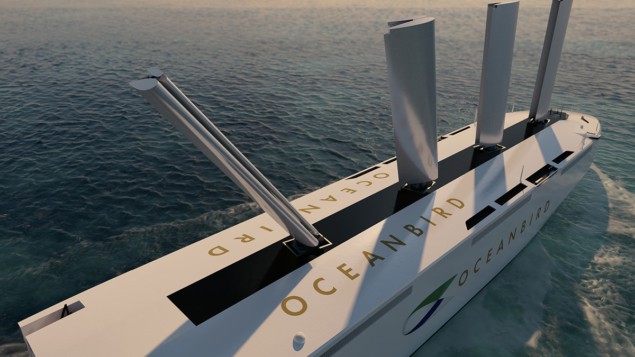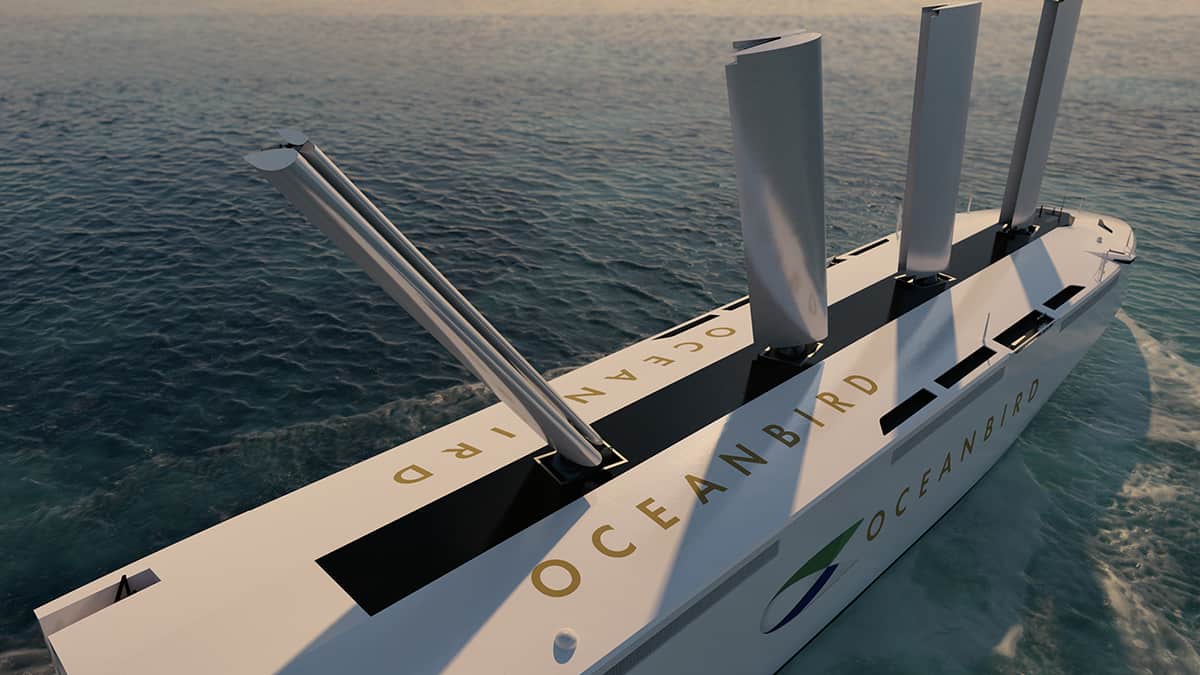Ships may be the lifeblood of the global economy, but they’re dirty and polluting. James McKenzie wonders if a new generation of wind-powered vessels could be the answer

I came across a meme the other day about wind-powered ships, where people were poking fun at Oceanbird – an odd-looking vessel being developed by the Swedish freight firm Wallenius Marine and the KTH Royal Institute of Technology in Stockholm. Well, the ship might appear strange, but it’s no joke. Tests on a scale model are already being carried out and the ship could become a reality as soon as 2024.
With financial backing from the Swedish Transport Administration, Oceanbird forms part of the country’s Wind Powered Car Carrier project. It aims to build a sailing vessel that can transport 7000 vehicles across the Atlantic with 90% fewer emissions than a conventional ship running on “heavy” crude oil. Oceanbird certainly looks different, with four giant, 80 m-high sails that seem more like sleek aircraft wings.
Towering vertically above the ship’s deck, the wings are made from steel and composite materials. Together, they provide forward thrust and can rotate through 360º to make optimal use of the prevailing wind. Some 198 m long and weighing 32,000 tonnes, Oceanbird would – if built – be the biggest sailing vessel in the world. It could cross the Atlantic in 12 days at a top speed of 10 knots.
That’s 50% slower than today’s fuel-burning ships, which have an average transatlantic journey time of 7–8 days, but think of all the fuel saved. Of course, a backup engine (hopefully not powered by conventional fuel) would be needed when the wind is sluggish or the ship is passing through harbours. The wings are also telescopic, which means the ship can pass beneath bridges and reduce wing area under high wind conditions.
All hands on deck
Developing a wind-powered ship might seem like a backwards step. After all, commercial sailing vessels traditionally required huge amounts of labour to set the sails, which also had to be physically huge and strong. And of course, wind is a highly unpredictable source of power. But with advances in materials science, automation and computational modelling, wind power is a really practical and green idea.
If you believe those in the industry, we’re on the verge of a new generation of wind-powered ships.
The International Windship Association currently has more than 100 members around the world working to deliver wind-powered ships. In fact, there’s an amazing amount of innovation and technology being investigated and evaluated. If you believe those in the industry, we’re on the verge of a new generation of wind-powered ships, boasting innovative sails, deployable kites to pull ships along, deck-mounted aerofoils and adjustable wing structures.
This work could play a key role in decarbonizing the shipping industry, where most vessels currently run on the dirty stuff left over after crude oil is refined. If it were a country, shipping would be ranked between Germany and Japan as the world’s sixth-largest emitter of carbon dioxide, spewing out nearly 3% of global emissions of greenhouse gases. Incredibly, the nitrogen oxides and sulphur oxide emissions from 15 of the largest ships match those from all the cars in the world.
Those problems are why the annual global market for wind-propulsion systems is set to grow from £300m now to about £2bn by the 2050s, according to the UK government’s Clean Maritime Plan. Wind-powered ships could help the International Maritime Organization (IMO) meet its ambitious goal of slashing carbon-dioxide emissions from ships by 70% by 2050 compared to 2008 levels. Maersk – the world’s largest shipping company – even hopes to cut carbon emissions to zero by that date (although how exactly remains unclear).
A July 2020 report by Deloitte and Shell paints a rosy picture of an industry recognizing its challenges and trying to solve them. Based on more than 80 interviews across the industry – from chief executives to financiers and ship builders – the report identified practical measures to cut carbon emissions. How, in particular, do you transform a sector that depends so much on cheap heavy fuel oils? And how do you adapt existing vessels that have been designed to last for 20 years or more?

Could ammonia be the secret to shipping carbon-free?
Operational efficiency will be key. Today’s largest vessels can already carry around 22,000 containers, compared with barely 1000 in the early 1970s, while ships have doubled in size over the last decade. Both developments have helped to cut the average emissions per container by roughly a third. In fact, per tonne mass and kilometre travelled, large ships now emit only 14% of the carbon dioxide from road vehicles, 6% of that from a cargo train and just 1% of that from a plane.
Consumer demands
Wind assistance seems key for new vessel designs but it’s risky when you realize that a new ship can cost up to $150m. The industry doesn’t have a clear path on technology and is also exploring several alternative fuels, including hydrogen, ammonia, methanol and biofuels. But all are problematic. Apart from needing new propulsion systems and storage tanks, we’d need to produce enough fuel to meet the 12 exajoule annual energy demand from shipping.
Perhaps the biggest challenge to making shipping greener is the lack of a global regulatory system.
Many see liquid natural gas, which has an energy density of 55 MJ/kg compared to 45 MJ/kg for heavy oil, as the only realistic short-term solution to hit the IMO’s interim target of cutting emissions by 40% by 2030. It’s 25% less carbon intensive and doesn’t emit as much nitrogen and sulphur oxide. Gas is also a mature technology, with many ships already able to use it. Longer term, ammonia (18.5 MJ/kg) and hydrogen (120 MJ/kg) are superior solutions even if ammonia is toxic and both need storing under high pressure. Batteries, though, aren’t realistic: apart from their tiny energy density (0.4 MJ.kg) you’d need loads on a ship, weighing it down.
But perhaps the biggest challenge to making shipping greener is the lack of a global regulatory system and the IMO being a member-based organization. What’s more, shipping is simply invisible to most consumers. As the Deloitte and Shell report points out, that lack of awareness makes consumers unwilling to demand change, especially when green products cost more. Still, I hope those wind-powered memes will one day be a thing of the past.
